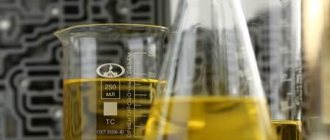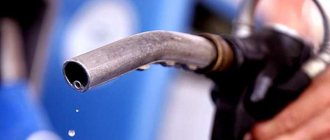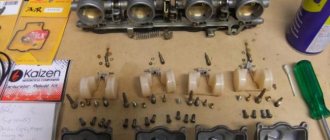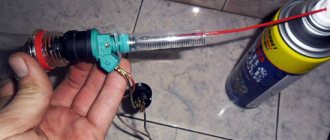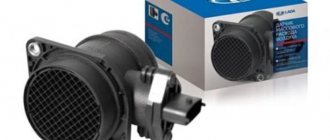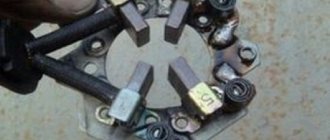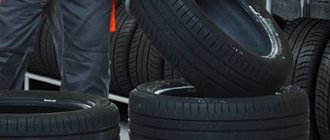The use of fuels and lubricants (in particular, gasoline) of not the best quality eventually ends in frequent breakdowns of the power unit. And any experienced car enthusiast knows very well that such fuel has a low octane number. This, in turn, leads to detonation of the working mixture in the combustion chamber. As a result, the service life of the engine is noticeably reduced, and repairs will have to be carried out much earlier. Moreover, everything can end very badly - with the death of the engine.
The solution suggests itself - fill the tank only with fuel that meets the needs of the power plant. It’s not for nothing that the manufacturer gives such valuable recommendations in the car’s instruction manual! Such a product is easy to find at gas stations in any city (especially large ones) or its environs.
But due to duty or for some other reasons (travel or car rides), a situation may certainly arise when fuel with the required characteristics cannot be found and you have to fill the tank with what is available. For this, it will be useful to know how to increase the octane number of gasoline. This information will be very useful for those drivers who often go on long trips.
But first, it’s worth considering the very definition of octane number and understanding what exactly is meant by this. And then we’ll look at several methods to increase it.
What does octane number mean?
The octane number of gasoline is a measure of knock resistance, or rather an indicator of various types of fuel and their ignition during operation of the internal combustion engine. At low octane levels, the use of such fuel is fraught with negative consequences for the engine due to fuel detonation. The most common: premature wear of valves and seats, as well as burnt residue on the walls and surfaces. Therefore, the octane number must be suitable for a particular engine, and we will look at how to increase the octane number in this article.
Driving on inappropriate fuel
It is not for nothing that the manufacturer guides everyone who decides to purchase a specific vehicle which brand of gasoline can be used. If you pour in the wrong fuel, don’t even doubt it, the car will run, but it’s unlikely that the vehicle will please you for a long time.
If the quality of gasoline does not meet the recommended one, the exhaust valves quickly overheat and burn out due to different temperatures and combustion durations. Exactly the same negative effect will be observed when motorists, on their own initiative, subject the ignition to incorrect adjustment. After burning out, the valves initially begin to trip, and subsequently stop functioning.
Most motorists categorically refuse to fill with low-octane gasoline, realizing that such a wrong step will provoke serious technical problems. It is precisely at those moments when they have to pour in such fuel due to the lack of high-octane gasoline that motorists decide to pour in suitable additives.
Methods for determining octane number
Officially, in Russia, the octane number is measured in two ways - “research” and “motor”.
These methods involve the use of specialized installations based on single-cylinder engines with the ability to control the compression ratio and temperature of the fuel mixture. The algorithms for measuring detonation resistance for these methods are the same. Gasoline samples are compared with reference mixtures. The objective of the study is to select a standard that will detonate with the same intensity as the fuel under study.
The difference between these methods lies in the operating modes of the installations in which the detonation resistance is studied. The “motor” method involves studying gasoline under conditions of maximum engine power at an increased temperature of the injected fuel-air mixture. During the test, the engine speed is 900 per minute, the temperature of the injected fuel-air mixture is 149 °C. It is conventionally believed that this mode of engine operation is typical for driving a car outside the city.
The “research” method makes it possible to determine the octane number of gasoline at partial engine load. The revolutions are set at 600 per minute, the injected fuel temperature is 52 °C. This mode of operation imitates the movement of a car in the city.
The values of research and motor octane numbers, as a rule, do not coincide. The difference between them is called fuel sensitivity. In this regard, when choosing fuel, it is necessary to pay attention to the method by which detonation resistance was determined. In addition, fuel labeling may vary from country to country.
For example, in Europe the main indicator is RON. In the USA and Canada, another parameter is common - AKI - the average value between research and motor octane numbers.
Due to the fact that the equipment operating manual specifies the requirements for gasoline with the markings of the country of origin, the owner of a foreign-made car should use octane number tables to select the most suitable fuel.
The above methods for determining detonation resistance are labor-intensive and require specialized equipment and reagents. At the same time, many car enthusiasts are interested in the question of how to check the octane number of gasoline at home. In this regard, the method of expressly assessing the octane number using so-called “octane meters” has become widespread.
These devices measure the dielectric constant of gasoline and compare the resulting value with a database stored in the device’s memory. However, this method is not highly accurate, since the readings of the device are highly dependent on the type of fuel additives used by gasoline manufacturers.
Using devices
Absolutely all instruments used to measure the value of OC have a single operating principle - determining the dielectric constant of gasoline, since this parameter depends proportionally on the value of OC. A mandatory measure is to draw up a special calibration relationship in order to obtain the most accurate value. This dependence is constructed taking into account n-heptane and fuel with a known octane number.
Among the most common devices of imported and domestic production are the following.
- OKTIS , a Russian-made device costing 3,500 rubles, is considered the most famous and in demand.
- Digatron is positioned as a more reliable and accurate device, the cost reaches 700 euros. The device has found application in karting and other sports.
- OKTAN-IM is distinguished by the presence of 10 calibrations and built-in internal memory. Demonstrates the highest possible accuracy of readings.
- OCTANOMETER PE-7300 M will cost approximately 50-60 thousand rubles. It features built-in software and the ability to connect to a PC. It is allowed to take into account the temperature indicator.
- SHATOX SX-100M is an imported analogue, the cost of which reaches $1,800. There is a built-in temperature sensor. This indicator is determined using a software method.
It is worth noting that the OR according to instrument measurements may differ significantly depending on the fuel manufacturer due to different calibration dependences. The construction of individual calibrations for each case is a mandatory measure. Gasoline from a specific manufacturer is usually used as a standard.
Among the disadvantages of the considered method for determining OC, one can highlight the difficulty of determining various external factors that can influence the measurement process. Another disadvantage is the impossibility of analyzing unidentified fuel, since the analysis is initially based on comparison.
Maximum octane number of gasoline
The development of internal combustion engine technology is moving along the path of increasing power and increasing efficiency. As these parameters increase, the requirements for the fuel used increase.
The use of additives based on organometallics (tetraethyl lead, ferrocene, etc.) makes it possible to obtain gasoline with a knock resistance of 130-140 units. However, in most developed countries, such additives to automobile fuel are prohibited for environmental reasons. Unleaded (tetraethyl lead-free) gasoline can have an octane number of up to 109 units.
Most modern cars are designed to use 95 or 98 octane gasoline.
Racing cars use fuel with a higher octane number - up to 102 (according to FIA technical regulations). The highest octane number of gasoline is typical for some types of aviation fuel - up to 115.
Why change the octane setting?
With a low octane number, gasoline may ignite much earlier than necessary. In this case, the engine power decreases, and the detonation process, well known to many car enthusiasts, appears.
In addition, the use of low-octane gasoline leads to engine detonation, reducing the service life of a whole group of its main elements - seats, valves, spark plugs, and so on. If you abuse low-quality fuel, the engine will have to be overhauled much earlier than scheduled.
So in order to improve the quality of gasoline and significantly improve its performance, it is still necessary to increase the octane number.
Basic methods
Today there are several main ways to increase octane.
Catalytic cracking.
A process that can only be implemented in an oil refinery environment. This method involves heating oil on a catalyst to temperatures slightly above 500 degrees Celsius.
During heating, the molar mass in Alkanes decreases, which allows the output of two elements - aromatic carbons and Alkenes.
As a result, gasoline with an octane number of 91-92. The disadvantage of such fuel is the high concentration of aromatic carbohydrates. Consequently, when storing fuel for a long time, the octane number may decrease.
Catalytic reforming.
Here, the fuel obtained after direct distillation is heated to 500-520 degrees Celsius. At the same time, the catalyst (rhenium, aluminum oxide with platinum and other metals) is under pressure of about 35 atmospheres. At the final stage, 95-grade gasoline is obtained. Efficiency is about 75%.
- As in the first case, this type of work is performed only under special conditions at the factory.
- Methyl tert-butyl ether.
This is one of the most popular additives for increasing the octane number of fuel. Its characteristics are colorlessness, easy flammability, low toxicity, strong odor and high octane level.
It is enough to add about 15% of this ether (of the total volume of fuel) to gasoline to increase the octane number by 8-12 points.
Most often, this method is used to increase octane. But it has a drawback - gasoline obtained in this way evaporates much faster in sunny weather due to its increased volatility.
Alcohol additives (based on ethyl or methyl alcohol).
Also used to improve fuel quality. For example, by adding 1/10 of ethyl alcohol to AI-92 gasoline, you can make it 95. At the same time, the toxicity of exhaust emissions from the car is significantly reduced.
- But this method has a number of disadvantages.
- Thus, the ability of alcohol to absorb moisture is manifested, which requires the car enthusiast to take additional measures to “dry” the gasoline.
- In addition, there is a high risk of blockages in the fuel system.
By the way, if no measures are taken, water appears in the fuel, which means increased consumption, incomplete combustion of the fuel mixture, a high risk of gasoline freezing in the system and other problems. Therefore, you will have to remove water from gasoline.
- Tetraethyl lead.
- One of the highest quality additives, which has been actively used since 1921.
- 1/20 of this substance is enough to raise the octane level by 15-18 positions.
- Tetraethyl lead is used in combination with special “carrier substances”, which remove the lead oxide formed during combustion of the additive.
Today this method has been banned due to dangerous lead fumes and their negative effects on the human body. The vapors of the substance are very poisonous.
In addition, such fuel cannot be used in cars with catalytic converters (the equipment breaks down after just a few hours of operation).
The evolution of fuel additives
Anti-knock additives are about a hundred years old. For a long time, the most popular additive for increasing octane number was tetraethyl lead (TEP), due to its relative cheapness and effectiveness. It continues to be added to aviation fuel in small quantities today. They learned about the toxicity of TPP almost immediately. But until the 90s of the last century, the fuel lobby managed to cope with the onslaught of environmentalists. In Russia, a ban on the production of leaded gasoline came into force in 2003.
Somewhat later, iron- and manganese-containing additives (cyclopentadienyltricarbonylmanganese, ferrocene, diisobutylene complex of iron pentacarbonyl, methylcyclopentadienyltricarbonylmanganese), which had approximately the same properties as thermal power plants, were subject to sanctions. They were widely used by the so-called small-scale producers, that is, medium and small fuel enterprises. It is quite difficult to identify such gasoline locally. A classic sign of their use in a car is the presence of red metallic deposits on the spark plugs.
Until recently, the main fuel additive for gasoline was monomethylaniline (MMA). It is considered one of the most effective reagents for increasing octane number in terms of price/quality ratio. It was used by almost all Russian fuel producers. By 2016, we switched to European standard 5, in which the use of MMA is prohibited. But for now, a complete ban on this additive has been postponed for several years.
Interestingly, the ban on MMA only applies to monomethylaniline. And if you take any other aniline derivative, then it will not formally fall under this ban, and its properties can be very close to MMA. It is unlikely that domestic manufacturers will abandon the use of MMA or its analogues even after the introduction of a complete ban.
MMA import statistics (according to customs statistics of foreign trade activities)
Firstly, such unscrupulous suppliers still need to be identified. For example, in the Siberian Federal District, a laboratory that can perform an analysis for MMA is not accredited to give an official conclusion. The second laboratory, which has the right to issue such a conclusion, does not know how to do such an analysis. We should not forget about the harsh realities of the Russian hinterland. If in large cities the regulatory authorities are still able to monitor the situation, then as they move “into the taiga”, the inspector will think several times before issuing a prohibitory order to the fuel supplier.
The fines provided for the use of MMA are not comparable to the financial losses from its refusal
Secondly, the fines provided for the use of monomethylaniline are not comparable to the financial losses from its refusal. Yes, some companies will be able to quickly reorient themselves to cheap Chinese analogues (for example, the same stabilized aniline), which are produced faster than any bans are introduced. But some will continue to pour into MMA.
So far we have talked mainly about anti-knock additives. In total, there are about 10 types of fuel additives for gasoline: anti-wear, restoring, detergent (the addition of which is mandatory today, for example, in the European Union) and so on. We can talk about each of them separately. For Russian consumers, the targeted use of gasoline with various additives is still a matter of fashion. When buying fuel with the prefix G-Drive and Ultra, you are most likely paying for that same “marketing” additive. From a chemical point of view, it is unlikely that G or Ultra gasoline will provide a significant increase in power and quality engine performance. Almost certainly, such fuel does not differ from the standard one, and a slight increase in consumer characteristics will be noticeable only on very powerful engines.
Share of supplying countries in the volume of MMA supplied to the Russian Federation in 2015
Additives for increasing the octane number of gasoline
To increase the octane number, aromatic hydrocarbons and branched paraffinic hydrocarbons (alkanes) are added using USB-type units. It is with the use of these components that the octane number increases. But as you noticed, the substances used are called aromatic (aromatic hydrocarbons), that is, in layman’s terms, high-octane gasoline smells stronger than low-octane gasoline. There are also certain disadvantages to this, since high-octane gasoline is more volatile due to the inclusion of aromatic components. Which, when stored for a long time in an open container or with a certain connection between the container and the external environment, leads to a decrease in the octane number of gasoline. Therefore, we can say that high octane gasoline must be “fresh”.
Previously, in the USSR, tetraethyl lead, a toxic mixture containing lead, was used to increase the octane number. Unfortunately, tetraethyl lead is not only toxic in itself, but also quickly damages catalytic converters and lambda probes, which have become used in the design of modern cars, as a result of which this additive had to be abandoned. Manganese-based additives were also used, but these are now also prohibited for environmental reasons. In addition, an additive called ferrocene is sometimes used to increase the octane number. This additive (ferrocene) contains iron and creates a difficult-to-remove conductive deposit on the spark plugs (a red tint), which impairs the performance characteristics (you can see about them in the “Spark Plugs” section) and accordingly reduces the service life of the spark plugs.
Gasolines also contain other additives and impurities. Additives in gasoline perform various tasks. They reduce the amount of harmful impurities in gasoline - sulfur, water, clean engine parts or the fuel system, increase the octane number of gasoline (this was mentioned above). A relatively harmless anti-knock additive for the engine is methyl tert-butyl ether. Currently, it is most widely used in Ukraine, Russia and Europe.
It is quite possible to obtain gasoline with an octane number of more than 110 (these are aviation fuels, but again with additives of the same lead, which, again, is unacceptable for modern car engine management systems). In addition, there is a well-known scheme with mixing gas condensate, because the octane number of natural gas is usually above 100.
Cleansing
Such additives are designed to prevent the formation of deposits and carbon deposits on the injector and other parts of the fuel system. They should be used regularly (every 10 thousand km).
If deposits have already formed, then the use of a detergent composition can lead to their detachment and entry into the fuel. This causes damage to the injectors.
Dehumidifiers
At low air temperatures, water may condense on the walls of the gas tank.
To prevent this, drying additives consisting of alcohol and absorbent substances are used.
Such formulations are ineffective and can only remove small amounts of liquid. They do not solve the problem of low-quality gasoline diluted with water.
Catalysts
This type of additive can increase the octane number of fuel. An artificial increase in this indicator is advisable only if it is not possible to refuel the car with high-quality fuel.
Universal
Universal compositions, according to the manufacturer, perform all 3 tasks described above. But laboratory tests show that the amount of active ingredients in them is small. As a result, such substances have almost no effect.
Description of additive types
The characteristics of various additives may differ depending on the composition and manufacturing technology, therefore, despite the general purpose, each type of additive has both advantages and disadvantages. Therefore, before we move on to the direct rating and determine which gasoline additive will be better, let’s consider the general characteristics of all four types.
Cleaning additives
Gasoline cleaning additives or detergent additives are designed to remove carbon deposits and resins from the surfaces of engine fuel system parts, including for cleaning the injector. Plaque forms over time even when using the highest quality fuel.
Gasoline additives that clean the fuel system are recommended to be used only as a preventive measure . This is due to the fact that with a significant mileage (over 100 thousand kilometers) without cleaning the fuel system, there is a risk of the opposite effect, that is, harm from using the additive. This can happen when, under the influence of a chemical composition, carbon deposits peel off from the surface of working parts and enter the fuel. Large particles can completely or partially damage the injectors.
Some automakers, for example, the VAG concern, produce special additives intended for use in the engines of cars produced by their manufacturers. A striking example is the Skoda Octavia A7, the regulations of which provide for the periodic use of its cleaning additive.
Considering that the price of a gasoline additive is relatively low (we will touch on this issue below) compared to the cost of a full procedure for cleaning a carburetor or injector, the product can be recommended as an effective method for preventing and cleaning the fuel system. You just need to use it regularly!
Sometimes on sale you can find additives in gasoline for decoking of rings. In fact, they are analogues of the cleaning compositions described above. It’s worth mentioning right away that at best they can be used for prevention, but in most cases they will be of no use. By buying them, you will only waste money for nothing. Other means are used for decoking.
Engine decarbonization
You can decarbonize engine rings and pistons with your own hands using one of the special tools. For different methods, a specific liquid is used. There are 10 reliable Read more
Drying additives
These compounds are designed to remove moisture from the fuel, which gets there as condensation formed on the walls of the gas tank and/or during refueling at gas stations in frosty weather. It would be useful to remind you that water in fuel is very dangerous. It is not only detrimental to the engine, but can simply freeze, damaging the fuel lines or filter mesh.
Drying additives consist of 80...90% alcohol. The rest of the volume consists of various chemical absorbent compounds. Before you buy an additive designed to remove moisture, you need to understand that in fact these products are ineffective! This means that they are able to remove only a small amount of moisture from the fuel (up to a maximum of 1%, in reality even less). Therefore, they can also be used only as a preventive measure. If you refuel with low-quality gasoline that contains water, you must drain it, otherwise the engine may be subject to water hammer.
Octane additives in gasoline
Description of the octane corrector
These additives for increasing the octane number of gasoline are also called fuel catalysts or octane correctors. In addition, according to manufacturers, they are able to reduce fuel consumption and increase engine power. Almost all of them consist of monohydric alcohols, ethers and allotropes of carbon. That is, from the same components as modern 92nd and 95th gasoline. And this is an obvious disadvantage, given the price of this product.
A can of octane gasoline additive is usually designed for 100...200 liters of fuel. This results in additional costs since regular gasoline costs less. It should also be taken into account that in practice the octane number increases not by the promised 5...7 units, but by the real 2 (approximately). Therefore, in most cases, advertising of octane correctors is a common marketing ploy, the purpose of which is to mislead the buyer (in most cases).
It makes sense to add an anti-knock additive only in one case - if you refuel with low-quality fuel , and the nearest gas station is still a long way to go. But if this happens, then it is better to drain the bad gasoline, clean the fuel system, and refuel with high-quality fuel.
Types of additives for increasing the octane number of gasoline
It is also worth carefully studying the composition, since there are 2 classes of additives - permitted and prohibited. Approved additives may consist of either MTBE (methyl tert-butyl ether) or MMA (monomethylaniline).
Among the prohibited additives for stabilizing gasoline, TEL (tetraethyl lead) is most often used, due to which exhaust gases become more toxic. An anti-knock agent can be ferrocene, an iron-containing additive that, when burned, forms a conductive coating on the surface of the spark plug, which leads to breakdown of the insulator.
Universal additives
Typically, these products are only an advertising product of their manufacturers, with rare exceptions. Miracles do not happen; one composition cannot successfully clean the fuel system, increase the octane number and remove moisture. Therefore, they are not recommended for purchase. As a last resort, buy a gasoline additive for the specific purposes described above.
Rating of the best additives
We have prepared a review, compiling the top 3 best additives for gasoline fuel. From the assortment of auto stores, only the highest quality and most effective ones were selected.
Liqui Moly Octane Plus (octane plus) - opens the rating with an octane corrector from a well-known German company. Recommended for use when detecting the fact of refueling with fuel that does not meet the octane number requirements. The tube has a volume of 150 ml, which is enough to fill 50-60 liters of gasoline. The manufacturer claims the possibility of increasing the octane number by 2-5.5 points (for AI92 and AI95, respectively). It is safe for health and does not damage engine structural elements. Cost 300-400 rubles.
TOTEK UMT is a domestic development created to increase the octane number and improve the performance characteristics of the fuel. It has a combined effect, which is to reduce fuel consumption by 5%, promote the formation of a protective film on fuel dosing elements and reduce the emission of harmful components into the atmosphere. A 0.5 liter package is enough for 250-270 liters of gasoline. The cost for one container unit is 600-700 rubles.
LAVR Oktane Plus - also belongs to the category of octane correctors. The manufacturer recommends its use if a high load is planned on the power unit. The positive aspects of use are an increase in octane number, protection of internal combustion engine elements, and reduction in consumption. Packaging: 310 ml bottle, which is enough for 100-120 liters of gasoline. Cost – 200 rubles.
Proper use of additives can significantly improve the performance characteristics of a vehicle and increase the service life of some engine parts. At the same time, use without measure can cause irreparable damage to the power unit.
Chemistry and business
At the consumer level, additives can be divided into two main classes - those that improve the quality of gasoline, and fuel additives that, roughly speaking, do not worsen the quality, but make it cheaper for the manufacturer. In principle, even flammable organic waste can be added to gasoline. That is, increasing the octane number from 92 to 95 is one type of additive. Dilute 92nd and make money on the difference - this is a different kind of “fuel additive”.
Both small and large businesses in Russia have always followed the path of least resistance. For most medium and small companies, it is easier and more profitable to purchase, say, “real” 92nd gasoline from a large manufacturer, add to it their own cheap fuel, relatively inexpensive additives and diluents, and receive the same 92nd grade, but at a different cost. Let's say, not 30 thousand rubles per ton, but 28 thousand. It is easy to calculate that with a turnover of 10 thousand tons of fuel per month (a small regional oil depot) you can already live well. We're not saying that all small producers are doing this. We are just saying that for domestic companies this is the most convenient option for doing business.
The consumer cannot distinguish high-quality gasoline from low-quality gasoline. Not by color, not by smell, not by appearance, not by gas station service
The consumer cannot distinguish high-quality gasoline from low-quality gasoline. Not in color, not in smell, not in appearance, not in gas station service. And this is almost impossible to do using a direct chemical method, for example, chromatography, since the original gasoline itself contains a wide range of organic compounds. A specialist can analyze individual fuel parameters only in the laboratory. A complete analysis of a fuel sample will cost 30-50 thousand rubles.
The next problem is that gasoline cannot be diluted indefinitely. At a certain stage, it begins to lose its lubricating properties. The same story applies to diesel fuels. Today they are trying to produce high-quality diesel with a low sulfur content. But with the desulfurization of diesel fuel, the load on the engine increases, and there is a need for lubricating additives. Almost all of them are currently imported to Russia.
Then the state comes into play and the situation becomes even more complicated. It regulates the fuel market, introduces standards and prohibitions stipulating the permissible content of metals and organic substances in fuel. That is, he cares not only about profit, but also about the environment. As a result, the manufacturer is forced to constantly maneuver between government requirements, consumer demand and their own concepts of profitability. The fuel additives market is a dynamic and highly selective environment. Those who manage to adapt faster survive.
How to use additives?
To get the maximum benefit from using fuel additives, they must be used correctly. Read the instructions for use in advance, and only then proceed to use. First of all, you need to prepare the engine, it should be washed. This is done in the following cases:
- Before a complete oil change.
- If you switch to another engine oil brand.
- If you need to restore your car after using low-quality petroleum products.
- After completion of repair work.
To flush the engine, you must use special flushing oils. You can buy them in special stores. Keep in mind that flushing oil is a transition component. It is used when it is necessary to switch to another engine oil. If you want to use fuel additives, use them only if you fill the tank full.
As fuel passes through the combustion chamber, the engine gets rid of soot and deposits. The rings of the piston system are gradually cleaned. To get maximum benefit, it is necessary to add additional additives to the engine lubrication system. After filling the fuel additive, you must drive especially carefully for the first 300 kilometers, not to overload the system with additional load.
What is a fuel additive
Motor gasoline is a flammable mixture of hydrocarbons (octane, hexane, heptane, etc.) released during the distillation of oil. It is not used in its pure form and is often diluted with special additives - other types of fuel and components - to change its properties. The introduction of fuel additives into gasoline is regulated by special standards (for example, GOST R 51105-97).
Additives added to gasoline account for only 2% of its volume. But despite this, they play an important role in the composition of the fuel, namely:
- They increase its resistance to detonation, that is, explosive combustion, which is indicated by knocking in a running engine, increased exhaust smoke and a sharp drop in power.
- Reduces engine overheating.
- They improve the volatility of gasoline and, accordingly, the formation of a combustible mixture when air enters.
- Reduces deposits in the engine and other mechanisms in contact with fuel.
- Reduces carbon deposits in the internal combustion chamber and exhaust system.
- Reduces the content of sulfur and benzene in exhaust gases.
Today, there are about two dozen chemical compositions, from which manufacturers obtain many additives by mixing the components in different ratios. According to their purpose, they are all divided into several separate groups.
In addition to special mixtures that are added to gasoline at oil refineries, there are independent fuel additives used by drivers when operating cars. These products are manufactured by third party manufacturers.
Alcohol based additives
In addition, the addition of ethyl and methyl alcohols to fuel is actively practiced. This method allows you to achieve significant increases in octane number. Using a moderate amount of 10 percent ethyl alcohol, gasoline type AI-92 can easily be upgraded to AI-95. Alcohol, by increasing the charge density, simultaneously reduces the detonation rate and the effect of high temperatures on the engine. All this is explained by the cooling of the combustible mixture due to increased gasification and evaporation during operation.
Naphthalene
An old means of fighting moths and other living creatures, forgotten by everyone except our grandmothers, has acquired a new lease of life as one of the types of additives. Just 500 grams of this substance in one canister of gasoline increases the octane rating by as much as three notches. But a harmless assistant in the form of a powder, interacting with fuel, begins to slowly and pragmatically harm the main systems of the car. First of all, these are carbon deposits in the combustion chamber, namely their increased quantity. In addition, the level of toxicity of exhaust gases increases significantly. In addition, naphthalene can crystallize and clog the gas pump compartment.
Acetone
Acetone in small quantities significantly increases detonation resistance. The addition of such an additive is regulated by government rules and regulations, so many manufacturers do not hesitate to increase the octane number using this method. The problem lies in the further addition of this substance to the compositions of low-quality gasoline, thus trying to obtain more of the required “fat.” The result is a multiple exaggeration of the permitted dose, which in turn is fraught with the decomposition of acetone into components harmful and toxic to humans.
Manganese additives
Manganese additives increase detonation resistance by 4-5 units. The disadvantages of such a product include periodic failure of the converters, thereby reducing the operating life of the engine.
Methyl tert-butyl ether
It is safe to say that this is the most promising component. Methyl tert-butyl ether (MTBE) has high detonation resistance - from 115 to 135 units. As a result, this has a positive effect on the operation of the power unit. The working air-fuel mixture burns completely, which helps reduce the content of CO and CH in the exhaust gases.
MTBE is a liquid with certain technical parameters:
- has no color;
- transparent;
- has a pungent odor;
- boiling point – from 48 to 55°C;
- density – from 740 to 750 kg/m3.
But there is also a minus here - the increased content of MTBE in gasoline (more than 20%) leads to a decrease in engine service life. In addition, this also contributes to an increase in nitrogen oxides, which enter the atmosphere along with exhaust gases.
For this reason, in Russia it is permissible to use gasoline with an MTBE content of no more than 15%. And as road tests show, unleaded gasoline containing 7-8% MTBE turns out to be much better than commercial fuel.
In addition to the disadvantage mentioned, methyl tertiary butyl ether leaves a red deposit on the surface of the combustion chamber or spark plugs. In this case, characteristic symptoms can be traced - a decrease in the car’s power, including engine tripping. The spark plugs themselves may simply fail over time.
Lead tetraethyl
It is also referred to as tetraethyl lead or TEL (formula Pb(C2H5)4). It is a colorless liquid of oily consistency with a boiling point of up to 200 °C. The use of this substance as an anti-knock agent began in 1921. But to this day, TPP remains a surefire way to increase the octane number. The content of this additive in an amount of 0.05% helps to increase the octane number of gasoline by 15-17 points.
In its pure form, tetraethyl lead is not added, since lead oxide, which is formed during the combustion of thermal power plants, is deposited on pistons, valves and other parts as carbon deposits.
In addition, adding Tetraethyl Lead to gasoline has positive aspects:
- Exhaust smoke is reduced.
- The engine is quieter than before, almost whispering.
- The power of the power unit also increases, albeit slightly.
- The likelihood of detonation is noticeably reduced or eliminated altogether.
Now is the time to touch on the other side of the coin - lead theatratel itself is highly toxic and therefore poses a threat to the human body. But its fumes can enter not only through the respiratory tract, but also through existing open wounds on the body.
In addition, TES has an increased neuroparalytic effect on a person, which can cause not only paralysis, but also death. In this case, the car also suffers - lead compounds are deposited in the pipes and pipes, which is fraught with negative consequences. This is especially critical in relation to engines with a carburetor and injection analogues.
Alcohol based additives
Another technique for increasing the octane number of fuel is the addition of alcohol, mainly ethyl and methyl. 10% ethanol is enough to get AI-95 from the AI-92 grade. Such an additive for increasing the octane number of gasoline can minimize the amount of toxic substances in exhaust gases. However, we cannot exclude the possibility of an increase in saturated vapor pressure, which may cause vapor locks to appear in the fuel line.
It is also worth noting the peculiarity of storing alcohols. The fact is that these are active moisture absorbers from the air and, in addition, are highly soluble in water. For this reason, alcohols require specific storage conditions and control of the alcohol component. As soon as these rules are violated, water will appear in the gasoline, which inevitably promises not only excessive fuel consumption, but also its incomplete combustion. And if there is more of it, then in winter you simply cannot avoid ice jams.
Another disadvantage of this additive is that it leads to corrosion of engine gaskets. As a result, separate layers form in a tank of gasoline, and if water gets in there, then here it is - vodka (when it is absorbed by alcohol). And every car enthusiast knows that any engine will not work on this popular product.
Monomethylaniline
Monomethylaniline (MMA) in small doses (within 1.3%) does not have a negative effect on engine systems, and at the same time increases the octane number. But if you overdo it with the concentration, it can cause increased carbon formation and “freezing” of valves and pumps. MMA is quite toxic to humans, and if vapors containing it enter the body, severe poisoning with serious consequences can occur.
Detergent additives
Detergent additives are generally considered harmless, since they have a sufficient balance of corrosion inhibitors, a demulsifier (it absorbs water) and the detergent component itself, among which the most popular is surfactants (surfactants). Thanks to the use of such a substance, soot and other deposits are better “corroded”. But it is extremely important to take into account the concentration of such a substance. An overdose (use of more than 10%) is fraught with poor engine starting, up to complete loss of performance.
Ferrocene
A popular mixture that was actively used until the beginning of 2000. Increasing the octane number of gasoline at home is quite simple, since with a small error the fuel will not burn the power unit. Ferrocene, when burned, releases a lot of soot, which also contains heavy metals that can conduct current. Subsequently, soot deposited on the spark plugs will quickly disable the modules. At the same time, it is almost impossible to get rid of this carbon deposits mechanically.
Other gasoline additives
There are several more “folk” additives that car enthusiasts add to fuel. In particular, we are talking about alcohol and acetone in gasoline. There are many conflicting opinions on this matter. Let's try to dot all the "E's".
The most popular and inexpensive fuel additive is acetone. Its price is much lower than factory additives, and the effect of use is close to them. In addition, the additives mentioned are approximately 90% acetone or similar chemical compounds. One recipe is to add about 150 grams of this product per 40 liters of gasoline (respectively, 75 grams per 20 liters).
You cannot use acetone with carburetor engines! It is destructive for him!
Another popular remedy in this vein is isopropyl alcohol . It has similar properties. Amount of use - 100 grams per 10...20 liters of gasoline. , alcohol and acetone can be added to fuel . According to one of the folk recipes, it is necessary to pour 30 grams of acetone and 50 grams of alcohol per volume of 10 liters of gasoline.
Another original product that car enthusiasts add to gasoline is solvent 646. It consists of toluene, ethanol, butanol, acetone and several other components.
What is the benefit of acetone when mixed with gasoline? There are a number of objective factors, including:
- Acetone is a volatile substance with a high oxygen content. This promotes better (complete) combustion of fuel. In turn, it causes an increase in engine efficiency and torque.
- Acetone is completely miscible with water. As a result, the moisture in the fuel system is completely removed with the exhaust gases. Isopropyl alcohol is also excellent at removing moisture.
- Acetone is a solvent, so it perfectly cleans the surfaces of fuel system parts from carbon deposits, resins and other debris. Moreover, it does this more gently than special solvents. Moreover, acetone can be used on an ongoing basis, which makes it possible to save on cleaning the fuel system in the service.
- The combustion temperature of acetone is ten times lower than that of gasoline. Consequently, it reduces the operating temperature of the engine. This is especially true under high loads and in the hot season. In addition, it significantly improves knock resistance.
- Acetone can be safely added to high-octane gasoline, because the car’s ECU will not generate errors and will accept the new fuel mixture perfectly.
Also, medical or technical ethyl alcohol can be added to the fuel in small quantities.
Thus, using cheaper, but no less effective chemical compounds will allow you to save your own money on car maintenance.
Instead of a conclusion
As you can see, it is impossible to unambiguously answer the question of which gasoline additive is better? It all depends on the specific goals and situation. As for additives for cleaning the fuel system, they can only be used for preventive purposes. If the mileage of a car without cleaning the relevant components exceeds 100 thousand kilometers, then the use of such compounds can only cause harm. Additives for removing moisture are only appropriate if you have poured low-quality fuel into the tank, and then only as a temporary remedy that does not guarantee protection. Similar reasoning is valid for octane correctors. It is useful to have them “just in case”.
To summarize, it is worth pointing out that the effectiveness of using additional additives, regardless of their purpose, has not been officially proven . Therefore, most often they are just a product of marketing, and in most cases they do not perform the tasks specified in their description, but there are exceptions. So you should always be skeptical when choosing one or another additive. Thus, the answer to the question of whether to use additives or not rests entirely with the car owner.
If we compare prices with the beginning of 2022 (the time of writing this article), then in the summer of 2022 prices increased significantly only for additives from foreign manufacturers (Liqui Moly, Hi Gear), by an average of 100 rubles. Domestic ones (LAVR, Sintec, TOTEK) on average increased in price by 40 rubles. Suprotek's products, when compared with other mentioned manufacturers, on the contrary, have decreased in price and become more accessible.
Is it worth filling
In order not to ruin your car’s engine, it is important not to thoughtlessly purchase additives at a car dealership and pour them into the unit uncontrollably, but to initially arm yourself with the recommendations of specialists and weigh all the arguments for and against the use of additives.
It is important to take into account that cunning enterprising businessmen, seeking to sell low-quality fuel at a higher price, even before selling it, add octane-increasing additives to the composition, misleading motorists. As a result, after the next portion of the additive is introduced directly by the car owner, a glut of additives occurs, which negatively affects the condition of the engine. For this reason, it is not recommended to use auto chemicals unless necessary. It will be much more efficient to get service at gas stations that you trust.
Effect of additives
Of course, high-octane fuel is a big plus for the engine. The latter works more stable, power increases, fuel consumption decreases, and so on.
That is why the obsolete and inefficient types of fuel AI-76 and AI-80 are gradually coming out of use. But there are certain risks here too.
If you fill your car with gasoline with a “makeshift” increased octane number, you may encounter a number of problems, starting with the usual replacement of spark plugs and ending with a major engine overhaul.
How to lower the octane number of gasoline
Time is moving forward by leaps and bounds - you will no longer find 76 and 80 gasoline at gas stations. But ten-year-old walk-behind tractors or go-karts, which are still working without problems, require exactly this kind of fuel. Buying new ones is not an option. Using, for example, 92 gasoline will lead to uneven engine operation. Therefore, it is necessary to reduce the octane number of the mixture.
How to do it? Let’s use “folk” methods - leave the open canister in the open air, every day the octane level decreases by 0.5. It is too long. Then we use kerosene as an additive - a method previously used for vintage cars. The only negative is that it is quite difficult to choose the proportions.
If you use this method, then before use you need to measure the octane number.
Measuring the octane number of gasoline
The octane number of gasoline is measured in various ways:
- Research octane number (RON) and motor octane number (MON). The difference between them is represented as the sensitivity of the fuel mixture.
- "Actual octane number." It is determined under real operating conditions on a special stand with the engine running.
- "Road" octane number. The result is as close as possible to the real mixture, because determined directly in the vehicle.
It is quite simple to measure the octane number in everyday life - there are many devices - octane meters - available for sale. Their operating principle is based on measuring the dielectric constant of gasoline. This value is proportional to the octane number. To determine the exact value, there are calibration tables - comparing fuel with an already known number and the use of n-heptane.
The principle of comparing control samples with other gasolines is inherent in the UIT-65 and UIT-85 motor units. The octane number of diesel fuel can be determined similarly. This method became possible because in the production of gasoline, the direct distillation method is no longer used, but campauding (mixing) is used.
The disadvantages of this method include the inability to analyze the octane number of unidentified gasoline, i.e. brands of gasoline not included in certain databases.
It is also difficult to create a unified model, and therefore it is difficult to analyze gasolines that are produced in different ways (cracking/reforming/others) and mixtures of different types.
The following restrictions apply to the use of this model: prior calibration against a standard is required and the temperature must be within the specific range specified in the instrument specification.
Use gasoline with parameters recommended by the manufacturer. Remember, failure to comply with these rules can lead to serious problems with the engine, including engine breakdown, the need for major repairs or replacement of valves and pistons. To measure the octane number of fuel, use the special instruments named in the article and similar to them.
Detonation resistance
Octane number, or octane index, is a parameter that characterizes the ability of gasoline not to ignite under compression.
The indicator is equal to the volumetric percentage of isooctane in a mixture with n-heptane, at which the detonation resistance of this liquid and the gasoline under study is the same.
Isooctane is extremely reluctant to ignite even at a very high compression ratio, so its octane number is taken to be 100. H-heptane, on the contrary, easily self-ignites even at a low compression ratio, therefore the value of its anti-knock parameter was set to zero.
The first to study the ability of gasoline to detonate in the 21st century was the Englishman Harry Ricardo. He suggested using a scale of gasoline resistance to detonation. For a long time, the main anti-knock additive for gasoline was tetraethyl lead. Adding just 0.01% of this substance to gasoline increases its knock resistance index by 3 units. But since it is very poisonous, its use as a gasoline additive is now prohibited.
Instead, in order to increase anti-knock properties, safer additives are now used, for example, methyl tert-butyl ether, which is considered today the most promising means for this purpose. Its mixture with tert-butyl alcohol is also used. The disadvantages of these additives are their high aggressiveness towards rubber products and low (about 50 ◦C) boiling point.
The latter is the reason for the evaporation of these additives from the fuel in the heat.
Regardless of the chemical nature of the antiknock agent, the concentration of the additive in gasoline is limited for objective reasons, which leads to a low increase in octane number. In addition, the increase in the gasoline knock resistance index depends nonlinearly on the additive concentration. For each antiknock agent there is a threshold concentration, after which the detonation resistance indicator does not increase.
What's the point
First, let’s figure out what kind of indicator this is and why it should be improved.
So, the octane number characterizes the detonation properties of gasoline, that is, its ability to ignite at the right time and with the required quality.
This is the main indicator that receives special attention. For example, if the octane rating of gasoline is AI-95, then this indicates its detonation by 95% (like isooctane) and 5% (like heptane).
At the very first moment after oil refining, gasoline has a minimum octane number of 70. Later, using various methods and additives, this figure can be raised to the desired level.
The octane number is determined on a special stand (often it looks like a special motor for testing). The test is performed under various loads - small and medium.
But recently, special devices have begun to appear that simplify testing.
The parameters of the fuel used for the experiment are compared with standard compositions of isooctane and heptane. After this, gasoline is assigned its own “number”.
By the way, each organic compound has its own level of detonation resistance.
For example, methane has an octane rating of 107.5; propane – 105.7; benzene – 113; butane – 93.6; straight distilled gasoline - about 58, catalytic cracking - about 80-85 and catalytic reforming - 83-97.
Comparison of the properties of various antiknock agents
Threshold concentration values for some additives and their other operational features:
- Oxygenates (lower alcohols and ethers). The threshold concentration of the additive is 15%. Features: relatively low heat of combustion and high aggressiveness towards rubber products. The maximum increase in fuel octane index is 4–6 units. Parameters of several esters used as additives. Methyl tert-butyl (MTBE) – average octane number 114, boiling point 55 ◦C; ethyl tert-butyl (ETBE) – average octane number 110, boiling point 70 ◦C; methyl tert-amyl (MTAE) – average octane index 104.5, boiling point 87 ◦C; diisopropyl (DIPE) – average octane index 104.5, boiling point 69 ◦C.
- Lead based additives. The threshold metal saturation of gasoline is 0.17 g/l. Features: high level of toxicity and carbon formation in the combustion chamber. The maximum increase in the gasoline detonation resistance index is 8 units. Such additives are not used nowadays.
- Containing manganese. The threshold concentration of metal in fuel is 50 mg/l. Features: increased wear of parts of the cylinder-piston group, significant carbon formation on the spark plugs and in the combustion chamber. The maximum increase in the detonation resistance index is 5–6 units.
- Iron-containing. Threshold concentration – 38 mg/l. Leads to increased wear of engine pistons and cylinders due to noticeable ash deposits during combustion. The maximum increase in the number of detonation resistance of gasoline is 3–4 units.
- Aromatic amines, for example, aminobenzene (aniline), which is prohibited for use in its pure form due to its extreme toxicity. Of the substances in this group, only monomethylaniline (N-methylaniline) is approved for use. Threshold concentration 1–1.3%. The peculiarity of the additive based on this substance is its high octane number. During the experiment, a value of 280 units was obtained. However, there are also significant drawbacks, which include significant resin deposits on engine parts and fuel system. There is also increased wear of parts of the cylinder-piston group. The maximum increase in the number of knock resistance of gasoline achieved by using such an additive is 6 units.
RV and compression ratio
Developments at automobile concerts are focused on preventing spontaneous combustion in engine components, which is why engines are produced with a high compression ratio. In this context, it is the octane number that is of paramount importance, since high octane fuel is required for engines with high compression ratios. They are used mainly in executive or sports cars. The compression ratio in modern cars can be 10 to 1, but higher rates are also found.
A specific OC is developed by the manufacturer separately for each model and brand of machine. Characteristics of this kind are indicated in the operating instructions, but what will be the consequences of ignoring the recommendations?
Using fuel fluid with a lower RH than required leads to the following consequences:
- detonation;
If the octane number in the fuel, on the contrary, is higher than necessary, the consequences will not be so dire. We are talking about a slight decrease in dynamics, since the combustible mixture will burn longer.
Reducing the risk of detonation using improvised means
- Adding 10% ethyl or any other alcohol to gasoline can increase its octane number by 3 units. The disadvantage of this method is the formation of vapor locks in the gas lines, which impede the operation of the fuel system. This is due to the rather low boiling point of alcohols, which is especially noticeable in hot weather. Another disadvantage of this technique is that alcohols are very hygroscopic and well absorb moisture from the air, which in severe frost will freeze, forming ice plugs in the fuel line. Of course, access to gasoline in this case will be blocked.
- You can increase the knock resistance of gasoline fuel by adding acetone to it. According to data published online by amateur experimenters, adding 1 liter of acetone to 20 liters of gasoline increases its octane number by 6 units. However, they did not carry out measurements, relying only on detonation. A car whose engine was designed for AI-98 was filled with AI-92, and acetone was added to the fuel until detonation disappeared.
- The use of additives to increase the knock resistance of gasoline, sold in auto chemical stores. It must be borne in mind that if you believe the reviews, additives containing iron and amine compounds are the most effective. Please note that additives containing iron can, especially if used systematically, cause spark plug failure.
Recommended octane number for the car
The question of which fuel is best to use for a car can be given a definite answer - the one prescribed for a specific type of engine. The use of low-octane gasoline, as mentioned earlier, will lead to detonation.
Many modern cars are equipped with anti-knock systems, so they can consume fuel with an octane rating lower than the recommended one. But at the same time, fuel consumption increases and engine power decreases, which makes trying to save in this way pointless.
However, using fuel with an octane number exceeding the recommended one will not be beneficial. At best, this will result in increased costs due to the higher cost of high-octane fuel. At worst, incomplete combustion of gasoline may occur.
Myths about octane number
At the beginning of the article, it was noted that only a few car owners clearly understand what octane number is. The result of this was the emergence of a large number of myths. And if some of them are relatively harmless, then believing in others can result in serious damage to the car.
Myth 1. The combustion temperature of high-octane gasoline is higher, so the engine develops more power. The octane number has nothing to do with the combustion temperature and the amount of heat released. All brands of gasoline have similar calorific values, so you should not expect to increase engine power by using high-octane fuel.
Myth 2: Octane rating can be measured with a portable device. All kinds of “octane meters” give a fairly approximate value of the octane number, so you should not rely on them entirely. The exact value of detonation resistance can only be obtained through bench tests.
